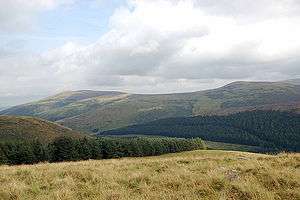Northumberland National Park
Northumberland National Parkis the most northerly park in England and covers 1030 km2. It is entirely within the county of Northumberland.

Understand
There are two main geographical areas within the park. The Cheviot hills to the north and Kielder Forest to the South West. The park is generally very quiet, it gets very few visitors compared to some of its more famous neighbours like the Lake District National Park.
History
The park was designated in 1956 and since then has steadily become more and more user friendly with visitor centres and programs to involve and educate visitors.
Landscape
The landscape is typically moorland, heather and conifer plantations. The Kielder reservoir is the largest body of water. Just over 70% of the area is open moorland. Heather is very common and approximately 20% of the park is heather moorland which gives beautiful autumn displays.This heather moorland is largely unique to the United Kingdom and recently there has been considerable habitat improvement with grouse moor management schemes.
Flora and fauna
|
The lynx effect There is an ongoing campaign by a group of scientists and conservationists to reintroduce Eurasian lynx to nearby Kielder Forest, an animal which became extinct in Britain in the Middle Ages. The controversial proposal has received mixed reactions locally: supporters argue the labrador-sized wild cat would bring many environmental benefits such as deer population control and a rebalanced ecosystem, while detractors fear that farmed sheep would prove an easier meal than the lynx's traditional diet of roe deer. One thing's for sure, the presence of a charismatic predator would certainly bring in the tourists. |
The park has red and roe deer, foxes, and badgers, while small mammals are very common. However the bird population is truly amazing. The open habitats host many different species including black grouse, curlew, merlin, and red grouse. Along the valleys are heron and kingfisher.
Climate
Generally wet and windy. The north easterly gales sweeping in off the Atlantic are a common feature of the area.
Get in
From the north. A1 from Edinburgh. From the south. Either the A68 from Corbridge or the A1 trunk road From the east. Many small roads providing access into the park. From the west. A69 through to Corbridge and then the A68 north. By plane into Newcastle airport. By train, north east line to Newcastle and stations north.
Fees and permits
None
Get around
Large areas of Northumberland National Park are accessible to the public - you can walk feely on designated ‘Access Land’ without having to stay on rights-of-way.
There are also visitor centres at Ingram, Once Brewed, Alnwick, Bellingham, Berwick-upon-Tweed, Brampton, Carlisle, Newcastle, Hexham, Morpeth, Wooler.
See
- Hadrian's Wall, UNESCO site from Roman times.
- Cheviot Hills and surrounding area with Hill forts and wide open moorland.
- Redesdale Valley and Border reiver history.
- Visit the many medieval castles.
Do
- Walking
- Riding
- Visit markets and fairs
- Bird watching
- Shooting and hunting
- Cycling
Buy
There are many craft shops and some woolen mills converted to sell clothing and related items.
Eat
Local food as expected centres around the rich landscape and game. So you get meat and fish dishes.
Drink
Northumberland brewery provides local ale.
Sleep
The area has plenty of B&B and self-catering accommodation. There are hostels and camping barns There are local businesses offering green accommodation and self-catering accommodation throughout Northumberland.
Connect
The official national park details are here .